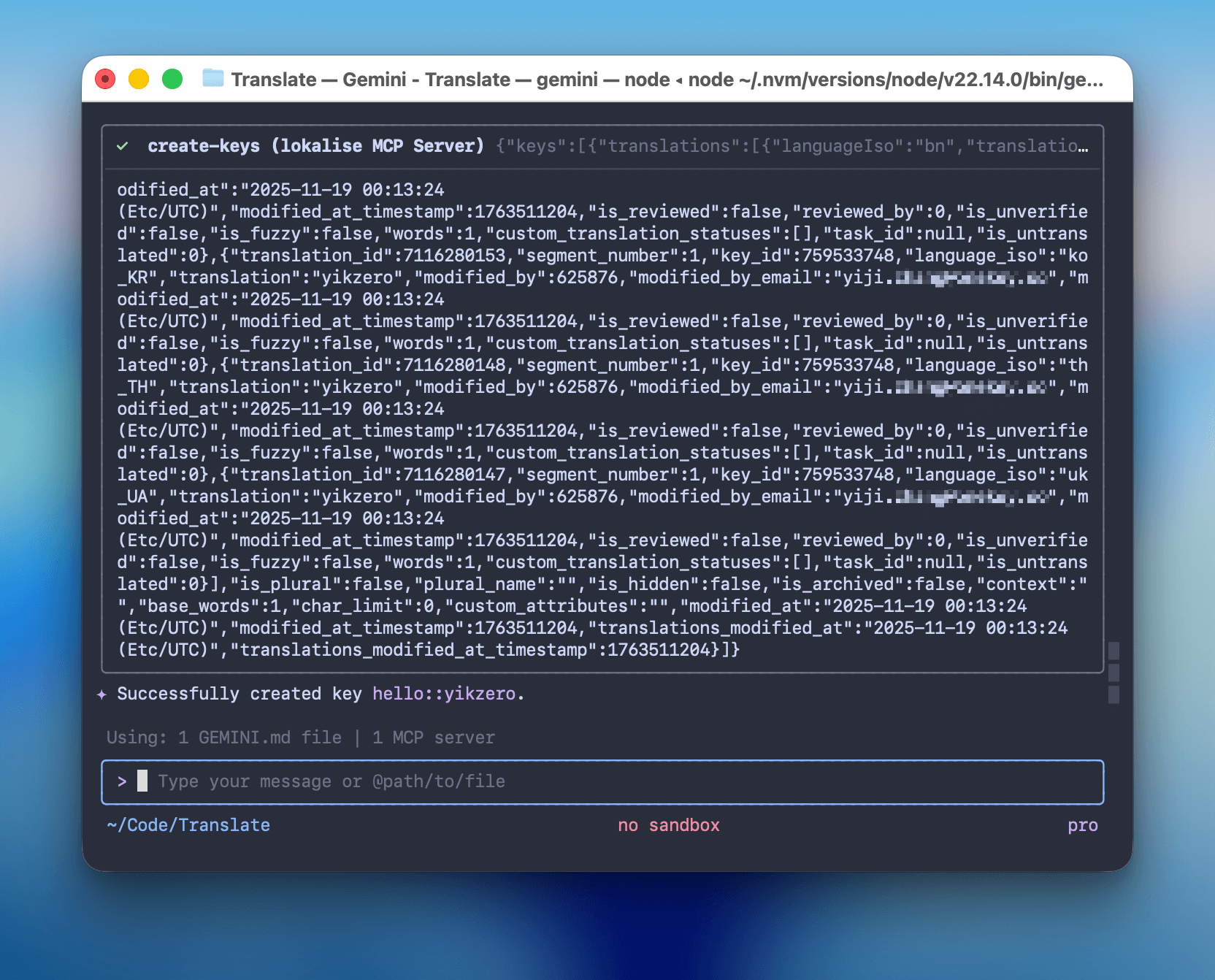Lokalise MCP 自动翻译方案
前言
俗话说得好,「偷懒」是第一生产力。在我们目前的需求设计流程中,会涉及到大量的语言翻译工作。每个需求都需要将稿件中的英文标题、描述翻译为中文、法语、日语、泰语等合计十八种语言,并最终通过翻译键 (Translation keys) 的形式提供给开发。这其实是一项重复率非常高并且非常繁琐的工作。我们需要找到方法能够偷懒,并且保证翻译质量。
目前我们使用的多语言平台是 Lokalise,所以接下来我讲的方案主要会围绕 Lokalise 展开,其他平台也可以参考。

基本思路
要实现全自动,其实就分两步走:
- 找个懂行的翻译:AI 翻译很强,但不懂业务术语(比如 "Gas" 翻译成 "气体"),可能还会把一些不需要翻译的词翻译出来。所以需要给 AI 注入业务上下文、定规矩。
- 给 AI 装上「手」:翻译完还得一条条复制粘贴到 Lokalise 后台,这才是最累的。通过 MCP 协议,让 AI 直接调用 Lokalise API。
最终方案
我选择的技术栈是 Node.js + MCP SDK + 客户端工具。
客户端的选择很灵活,只要支持 MCP 均可。最开始我用的是 Claude Desktop,但对于喜欢命令行的朋友,完全可以替换成 Claude Code 或者 Gemini CLI,效果一样丝滑。
可能 Gemini 对于翻译这种文科类工作更加擅长,推荐一下。
1. 核心代码 (MCP Server)
Lokalise 本身提供了完善的 REST API,这正好方便我们通过代码来操作它。
为了少写点样板代码,我直接使用了官方的 Node.js SDK (@lokalise/node-lokalise-api)。参考 MCP 的官方文档,我把这些 API 包装成了一个 MCP Server。
它主要暴露了两个工具给 AI:
search-keys: 用来查重,看看是不是已经有人翻译过了。create-keys: 用来干活,把 AI 生成好的多语言文案写入后台。

逻辑其实并不复杂,本质上就是做一个 API 的二传手:
点击查看 index.ts 核心代码
#!/usr/bin/env node
import { McpServer } from "@modelcontextprotocol/sdk/server/mcp.js";
import { StdioServerTransport } from "@modelcontextprotocol/sdk/server/stdio.js";
import { LokaliseApi, SupportedPlatforms } from "@lokalise/node-api";
import { z } from "zod";
const LOKALISE_API_KEY = process.env.LOKALISE_API_KEY;
const DEFAULT_PROJECT_ID = process.env.DEFAULT_PROJECT_ID;
const DEFAULT_PLATFORMS = ["web", "ios", "android", "other"];
const PLATFORMS = (
process.env.PLATFORMS
? process.env.PLATFORMS.split(",").map((p) => p.trim())
: DEFAULT_PLATFORMS
) as SupportedPlatforms[];
const lokaliseApi = new LokaliseApi({ apiKey: LOKALISE_API_KEY });
const server = new McpServer(
{
name: "lokalise-mcp",
version: "1.0.0",
author: "yikZero",
},
{
capabilities: {
tools: {},
},
}
);
// ... get-project-info 和 search-keys 工具代码略 ...
server.registerTool(
"create-keys",
{
title: "Create Keys",
description: "Creates one or more keys in the project",
inputSchema: {
projectId: z
.string()
.describe(
"A unique project identifier, if not provide, first use get-project-info tool to get the project id"
),
keys: z.array(
z.object({
keyName: z.string().describe("Key identifier"),
platforms: z
.array(z.enum(["web", "ios", "android", "other"]))
.describe(
"Platforms for the key. If not provided, use the default platforms: " +
PLATFORMS.join(", ")
),
translations: z
.array(
z.object({
languageIso: z
.string()
.describe(
"Unique code of the language of the translation, get the list from the get-project-info tool"
),
translation: z
.string()
.describe("The actual translation. Pass as an object"),
})
)
.describe("Translations for all languages"),
})
),
},
},
async ({ projectId, keys }) => {
const response = await lokaliseApi.keys().create(
{
keys: keys.map((key) => ({
key_name: key.keyName,
platforms: key.platforms,
translations: key.translations.map((t) => ({
language_iso: t.languageIso,
translation: t.translation,
})),
})),
},
{ project_id: projectId }
);
return {
content: [
{
type: "text",
text: JSON.stringify(response),
},
],
structuredContent: response as any,
};
}
);
// ... update-keys 工具代码略 ...
async function main() {
const transport = new StdioServerTransport();
await server.connect(transport);
console.error("Lokalise MCP Server running on stdio");
}
main().catch((error) => {
console.error("Fatal error in main():", error);
process.exit(1);
});2. 调教 AI (Prompt)
这其实就类似 Claude 网页版里的 Project 功能,他会让你预置一些系统提示词,提供一些资料。这都属于给 AI 背景知识,方便其更好的工作。
所以为了让 AI 像个老员工一样,我把所有关于 OneKey 的术语表(Glossary)、Key 的命名规范(Snake Case)都写进了一个 GEMINI.md 文件里,如果用的是 Claude Code,也可以写一份 CLAUDE.md。
现在其实也有个统一的 AGENTS.md,只不过还没完成有统一大业。
查看 GEMINI.md 提示词详情
You are a professional web3 project i18n translation expert specializing in translating word/sentence into multiple languages for software localization.
<onekey_background>
OneKey is a comprehensive cryptocurrency wallet solution...
</onekey_background>
<i18n_supported_languages>
English (United States), Bengali, Chinese Simplified...
</i18n_supported_languages>
<technical_terms>
OneKey, WalletConnect, iCloud, Google Drive, OneKey Lite, OneKey KeyTag, Face ID, Touch ID, Discord, X, GitHub, recovery phrase, QR-based, NFT, Defi, USB, Mint, Meme, GameFi, Lido, Passphrase...
</technical_terms>
<translation_namespaces>
global, onboarding, wallet, swap, earn, market, browser, settings, prime
</translation_namespaces>
Translation Process:
1. Direct Translation:
- Provide a literal translation of the word/sentence into all supported languages
- If the text contains a number, replace it with {number}
- Preserve all technical terms and variables, like {variableName}, HTML tags, etc
2. Refined Translation:
- Create an optimized version that enhances clarity and natural flow in each language
- Ensure cultural appropriateness while preserving the original meaning
- The title needs to be used Sentence case
- A space (half-width space) between a full-width character (Kanji) and a half-width character (letter, number, or symbol)
3. Key Generation:
- Create a self-explanatory key in snake_case format
- Structure as namespace::descriptive_key_name
4. **Filtering Logic**:
- IGNORE common UI elements that likely already exist in the 'global' namespace, such as: "Close", "Open", "Cancel", "Confirm", "Back", "Next", "Done". Do NOT generate keys for these.
- Only focus on the unique, business-specific text in the provided context.
Output Format:
1. Key: [namespace::descriptive_key_name]
2. Direct Translation Table (brief reference)
3. Refined Translation Table (primary focus)
Items need checked:
1. If the user provides the Key, use the user-provided Key.
2. If there is an obvious spelling error, I need your help to correct it and inform you.
3. After the translation is completed, need to call the tool to create/update the corresponding key.3. 配置文件
最后,在 MCP 配置文件(如 claude_desktop_config.json 或 .mcp.json)里,把我们写好的 Server 挂载上去。
{
"mcpServers": {
"lokalise": {
"command": "node",
"args": ["/Users/yikzero/Code/lokalise-mcp/build/index.js"],
"env": {
"LOKALISE_API_KEY": "xxxx969xxxxxxxx7c18760c",
"DEFAULT_PROJECT_ID": "44xxxxxe4ef8.8099xx5",
"PLATFORMS": "ios,android,web,other"
}
}
}
}实际效果
最好的场景是配合设计稿使用了。
之前每次设计完稿,我都要对着设计稿把文案一个个敲下来。现在可以直接导出设计稿。
比如我在 Figma 里刚画完一个新的 Onboarding 弹窗,随手截个图扔给 AI,说一句(如果过长推荐让其列个 To-Do List):
"这是一个新的导入钱包弹窗,把里面的文案处理一下。"
AI 会自动执行以下操作:
- 视觉识别:利用模型自带的视觉能力,直接提取截图中的文案。
- 双重翻译:这是保证质量的关键。它会严格按照 Prompt 的要求,先生成一份「直译表」以确保变量(如
{number})和术语准确,然后再生成一份「意译表」来润色文案(比如处理日语的全角半角空格、标题的 Sentence case)。 - 自动入库:确认意译结果无误后,它会自动生成
onboarding::import_phrase_title这种规范的 Key,通过 MCP 将 18 种语言的翻译一次性写入 Lokalise。
写在最后
用 Claude 写一个 MCP Server,再供给 Gemini CLI 调用,让他们更好的干活。也不知道谁才是资本家(误。